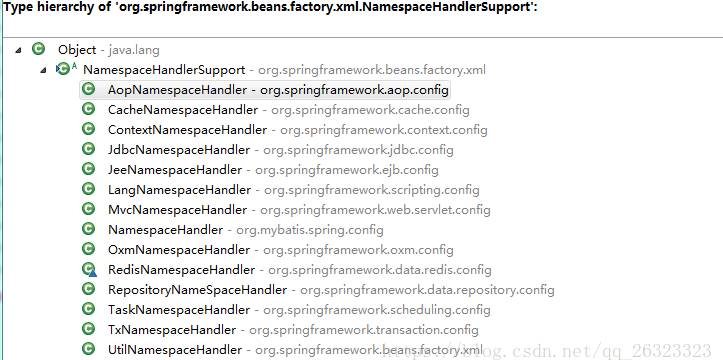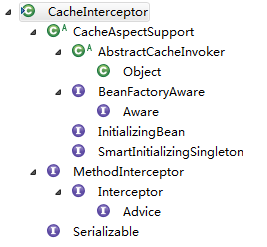缓存是我们常用的一种优化系统的方案。
无论是前端缓存还是应用层缓存或者数据库缓存,其本质都是将查询过的数据缓存下来,下次再次查询该数据的时候如果数据没有过期,则直接返回缓存中该数据即可,不再执行查询操作。
SpringCache是我们常用的一种应用层缓存方案,其一般应用在方法上,下面我们先来看下具体的使用方式,然后再从源码角度分析其实现方案
1.SpringCache的使用
1)maven引入依赖
cache功能相关代码都在spring-context中,一般使用Spring的项目中都有该包,所以不用再单独引入
2)Service(业务处理类,代码参考网上文章,非原创,有改动)
// 接口类 package cache; public interface IService { Account getAccountByName(String userName); void updateAccount(Account account); } // 实现类 public class AccountService implements IService{ @Override @Cacheable(value = "accountCache") // 使用了一个缓存名叫 accountCache public Account getAccountByName(String userName) { // 方法内部实现不考虑缓存逻辑,直接实现业务 System.out.println("real query account." + userName); return getFromDB(userName); } @Override @CacheEvict(value="accountCache",key="#account.getName()") public void updateAccount(Account account) { updateDB(account); } @CacheEvict(value = "accountCache", allEntries = true) public void reload() { } private Account getFromDB(String acctName) { System.out.println("real querying db..." + acctName); return new Account(acctName); } private void updateDB(Account account) { System.out.println("real update db..." + account.getName()); } }
如上所示:在方法上加上@cacheable等注解即可
3)Spring-cache-anno.xml文件(用于定义bean)
<?xml version="1.0" encoding="UTF-8"?> <beans xmlns="http://www.springframework.org/schema/beans" xmlns:xsi="http://www.w3.org/2001/XMLSchema-instance" xmlns:cache="http://www.springframework.org/schema/cache" xmlns:p="http://www.springframework.org/schema/p" xsi:schemaLocation="http://www.springframework.org/schema/beans http://www.springframework.org/schema/beans/spring-beans.xsd http://www.springframework.org/schema/cache http://www.springframework.org/schema/cache/spring-cache.xsd"> <!-- 添加driven --> <cache:annotation-driven /> <bean id="accountServiceBean" class="cache.AccountService" /> <!-- generic cache manager --> <bean id="cacheManager" class="org.springframework.cache.support.SimpleCacheManager"> <property name="caches"> <set> <bean class="org.springframework.cache.concurrent.ConcurrentMapCacheFactoryBean" p:name="accountCache" /> </set> </property> </bean> </beans>
使用默认的SimpleCacheManager
4)测试(测试缓存是否生效)
public class Test { public static void main(String[] args) { ApplicationContext context = new ClassPathXmlApplicationContext("spring-cache-anno.xml"); IService s = context.getBean(IService.class); // 第一次查询,应该走数据库 System.out.print("first query..."); s.getAccountByName("somebody"); // 第二次查询,应该不查数据库,直接返回缓存的值 System.out.print("second query..."); s.getAccountByName("somebody"); System.out.println(); } } //result: first query... real query account.somebody real querying db...somebody second query...
总结:根据结果可以看到,第二次查询的时候没有真正执行getFromDB()方法,而是从缓存中取的数据
2.写在源码分析之前
如果是我们来做的话,如何实现该功能?
基于我们对Spring的一贯理解,这应该是个代理,我们在获取IService的bean时候,应该获取的是个代理类,代理类执行业务方法,先去查询是否在缓存中有该数据,如果有则直接从缓存中获取,如果没有,则调用AccountService的方法
3.SpringCache源码结构分析
根据我们的示例可知,真正的内容都放在配置文件里了
配置文件中添加了一个driven(真正的功能应该在这里实现的)
<cache:annotation-driven />
下面是两个bean(accountServiceBean是我们需要的,需要将AccountService注入到容器中。
至于SimpleCacheManager暂时不知道其作用,只知道其实现了CacheManage接口,我们先暂时放一下)
<bean id="accountServiceBean" class="cache.AccountService" /> <!-- generic cache manager --> <bean id="cacheManager" class="org.springframework.cache.support.SimpleCacheManager"> <property name="caches"> <set> <bean class="org.springframework.cache.concurrent.ConcurrentMapCacheFactoryBean" p:name="accountCache" /> </set> </property> </bean>
1)<cache:annotation-driven/>的分析
但凡这种注解,都有对应的解析器,从之前分析AOP功能的源码可知,解析器都实现了NamespaceHandlerSupport类,我们来获取下NamespaceHandlerSupport的实现类都有哪些

里面有一个叫做CacheNamespaceHandler的类,看名字就像这个,我们来看下这个类
2)CacheNamespaceHandler
public class CacheNamespaceHandler extends NamespaceHandlerSupport { static final String CACHE_MANAGER_ATTRIBUTE = "cache-manager"; static final String DEFAULT_CACHE_MANAGER_BEAN_NAME = "cacheManager"; ... @Override public void init() { // 主要是这句代码 registerBeanDefinitionParser("annotation-driven", new AnnotationDrivenCacheBeanDefinitionParser()); registerBeanDefinitionParser("advice", new CacheAdviceParser()); } }
Spring会默认调用其init()方法,annotation-driven对应的是AnnotationDrivenCacheBeanDefinitionParser解析器,我们来看下这个解析器的作用
3)AnnotationDrivenCacheBeanDefinitionParser
@Override public BeanDefinition parse(Element element, ParserContext parserContext) { String mode = element.getAttribute("mode");// mode默认为proxy if ("aspectj".equals(mode)) { // mode="aspectj" registerCacheAspect(element, parserContext); } else { // 直接调用该方法 registerCacheAdvisor(element, parserContext); } return null; } // registerCacheAdvisor() private void registerCacheAdvisor(Element element, ParserContext parserContext) { // 1.注册ProxyCreator类 在4)中详细分析 AopNamespaceUtils.registerAutoProxyCreatorIfNecessary(parserContext, element); // 2.注册CacheAdvisor 在5)中详细分析 SpringCachingConfigurer.registerCacheAdvisor(element, parserContext); if (jsr107Present && jcacheImplPresent) { // 默认不会调用 JCacheCachingConfigurer.registerCacheAdvisor(element, parserContext); } }
4)AopNamespaceUtils.registerAutoProxyCreatorIfNecessary(parserContext, element)
public static void registerAutoProxyCreatorIfNecessary( ParserContext parserContext, Element sourceElement) { // 重点在这里 BeanDefinition beanDefinition = AopConfigUtils.registerAutoProxyCreatorIfNecessary( parserContext.getRegistry(), parserContext.extractSource(sourceElement)); useClassProxyingIfNecessary(parserContext.getRegistry(), sourceElement); registerComponentIfNecessary(beanDefinition, parserContext); } // AopConfigUtils.registerAutoProxyCreatorIfNecessary() public static BeanDefinition registerAutoProxyCreatorIfNecessary(BeanDefinitionRegistry registry, Object source) { // 重点在这里 return registerOrEscalateApcAsRequired(InfrastructureAdvisorAutoProxyCreator.class, registry, source); }
可以看到,主要是为了将InfrastructureAdvisorAutoProxyCreator注册到容器中
5)SpringCachingConfigurer.registerCacheAdvisor(element, parserContext)
private static void registerCacheAdvisor(Element element, ParserContext parserContext) { if (!parserContext.getRegistry().containsBeanDefinition(CacheManagementConfigUtils.CACHE_ADVISOR_BEAN_NAME)) { Object eleSource = parserContext.extractSource(element); // 1.注册AnnotationCacheOperationSource类到容器中 RootBeanDefinition sourceDef = new RootBeanDefinition("org.springframework.cache.annotation.AnnotationCacheOperationSource"); sourceDef.setSource(eleSource); sourceDef.setRole(BeanDefinition.ROLE_INFRASTRUCTURE); String sourceName = parserContext.getReaderContext().registerWithGeneratedName(sourceDef); // 2.注册CacheInterceptor类到容器中 RootBeanDefinition interceptorDef = new RootBeanDefinition(CacheInterceptor.class); interceptorDef.setSource(eleSource); interceptorDef.setRole(BeanDefinition.ROLE_INFRASTRUCTURE); parseCacheResolution(element, interceptorDef, false); parseErrorHandler(element, interceptorDef); CacheNamespaceHandler.parseKeyGenerator(element, interceptorDef); interceptorDef.getPropertyValues().add("cacheOperationSources", new RuntimeBeanReference(sourceName)); String interceptorName = parserContext.getReaderContext().registerWithGeneratedName(interceptorDef); // 3.注册BeanFactoryCacheOperationSourceAdvisor类到容器中, RootBeanDefinition advisorDef = new RootBeanDefinition(BeanFactoryCacheOperationSourceAdvisor.class); advisorDef.setSource(eleSource); advisorDef.setRole(BeanDefinition.ROLE_INFRASTRUCTURE); // 注意这里,将AnnotationCacheOperationSource和CacheInterceptor作为其属性注入进来 advisorDef.getPropertyValues().add("cacheOperationSource", new RuntimeBeanReference(sourceName)); advisorDef.getPropertyValues().add("adviceBeanName", interceptorName); if (element.hasAttribute("order")) { advisorDef.getPropertyValues().add("order", element.getAttribute("order")); } // 注意这句,将BeanFactoryCacheOperationSourceAdvisor类的注册名称设置为 // org.springframework.cache.config.internalCacheAdvisor // 在下面会用到这个名称 parserContext.getRegistry().registerBeanDefinition(CacheManagementConfigUtils.CACHE_ADVISOR_BEAN_NAME, advisorDef); ... } }
总结:由以上分析可知,我们添加<cache:annotation-driven />注解,主要是将以下类注入进Spring容器
* InfrastructureAdvisorAutoProxyCreator
* AnnotationCacheOperationSource
* CacheInterceptor(主要的拦截功能都实现在这里)
* BeanFactoryCacheOperationSourceAdvisor(重点关注这个,这个类在创建代理的时候被使用)
我们暂时只知道加载driven注解的时候,只是将这四个类注入到Spring容器中,而这些类具体在做什么,我们也不知道,更不知道与我们的AccountService类有什么关联。这些我们先暂时放一下,先看下CacheInterceptor和InfrastructureAdvisorAutoProxyCreator的功能简介
4.CacheInterceptor功能简单分析
其代码结构如下

可知:
* 其实现了InitializingBean接口,则CacheInterceptor创建的时候会默认调用afterPropertiesSet()方法;
* 其实现了SmartInitializingSingleton接口,则CacheInterceptor创建的时候会默认调用afterSingletonsInstantiated()方法
* 其实现了MethodInterceptor接口,则在被其拦截的方法上,默认会调用其invoke()方法
有关于这些接口的作用,不太明白的同学可以先看下对应的文章了解其大致作用
1)初始化afterPropertiesSet()方法
// 只是做了校验,没有其他功能 public void afterPropertiesSet() { Assert.state(getCacheOperationSource() != null, "The 'cacheOperationSources' property is required: " + "If there are no cacheable methods, then don't use a cache aspect."); Assert.state(getErrorHandler() != null, "The 'errorHandler' property is required"); }
2)初始化afterSingletonsInstantiated()方法
public void afterSingletonsInstantiated() { if (getCacheResolver() == null) { // Lazily initialize cache resolver via default cache manager... try { // 重点在这里 // 从工厂类中获取CacheManager的实现类 // 这里就与我们的Spring-cache-anno.xml配置文件中的创建的cacheManager // bean关联起来了,在配置文件中创建的bean实现了接口CacheManager // 则会在这里被使用 setCacheManager(this.beanFactory.getBean(CacheManager.class)); } ... } this.initialized = true; } // setCacheManager() public void setCacheManager(CacheManager cacheManager) { // private CacheResolver cacheResolver; this.cacheResolver = new SimpleCacheResolver(cacheManager); }
3)invoke()执行拦截方法(这个我们暂时先不分析,读者只需要知道这个拦截方法的存在即可)
public Object invoke(final MethodInvocation invocation) throws Throwable { Method method = invocation.getMethod(); CacheOperationInvoker aopAllianceInvoker = new CacheOperationInvoker() { @Override public Object invoke() { try { return invocation.proceed(); } catch (Throwable ex) { throw new ThrowableWrapper(ex); } } }; try { return execute(aopAllianceInvoker, invocation.getThis(), method, invocation.getArguments()); } catch (CacheOperationInvoker.ThrowableWrapper th) { throw th.getOriginal(); } }
总结4:
CacheInterceptor主要是一个方法拦截器,在初始化的时候将CacheManager的实现类(由用户自定义实现)添加进来;
invoke()方法,真正执行拦截的方法
5.InfrastructureAdvisorAutoProxyCreator功能分析
其代码结构如下:

可以看到,其实现了BeanPostProcessor接口,则Spring在创建bean的时候,会默认调用InfrastructureAdvisorAutoProxyCreator的postProcessAfterInitialization()方法,就是在这个方法中创建代理类的,下面我们来看下这个方法
1)AbstractAutoProxyCreator.postProcessAfterInitialization()
public Object postProcessAfterInitialization(Object bean, String beanName) throws BeansException { if (bean != null) { Object cacheKey = getCacheKey(bean.getClass(), beanName); if (!this.earlyProxyReferences.contains(cacheKey)) { // 重要方法 return wrapIfNecessary(bean, beanName, cacheKey); } } return bean; } // wrapIfNecessary() protected Object wrapIfNecessary(Object bean, String beanName, Object cacheKey) { ... // 1.获取当前类的所有切面拦截类,在2)中详细分析 Object[] specificInterceptors = getAdvicesAndAdvisorsForBean(bean.getClass(), beanName, null); // 2.如果拦截类不为空,则需要创建当前类的代理类 if (specificInterceptors != DO_NOT_PROXY) { this.advisedBeans.put(cacheKey, Boolean.TRUE); // 3.创建代理类,在3)中详细分析 Object proxy = createProxy( bean.getClass(), beanName, specificInterceptors, new SingletonTargetSource(bean)); this.proxyTypes.put(cacheKey, proxy.getClass()); return proxy; } this.advisedBeans.put(cacheKey, Boolean.FALSE); return bean; }
以上逻辑类似于之前分析的AOP源码,读者也可以先看下 https://blog.csdn.net/qq_26323323/article/details/81012855
2)getAdvicesAndAdvisorsForBean()获取当前类的所有切面拦截器
本方法为抽象方法,实现由子类AbstractAdvisorAutoProxyCreator实现
protected Object[] getAdvicesAndAdvisorsForBean(Class<?> beanClass, String beanName, TargetSource targetSource) { List<Advisor> advisors = findEligibleAdvisors(beanClass, beanName);//重点在这里 if (advisors.isEmpty()) { return DO_NOT_PROXY; } return advisors.toArray(); } // findEligibleAdvisors() protected List<Advisor> findEligibleAdvisors(Class<?> beanClass, String beanName) { // 1.获取所有的Advisor List<Advisor> candidateAdvisors = findCandidateAdvisors(); // 2.获取适合当前类的Advisor List<Advisor> eligibleAdvisors = findAdvisorsThatCanApply(candidateAdvisors, beanClass, beanName); extendAdvisors(eligibleAdvisors); if (!eligibleAdvisors.isEmpty()) { eligibleAdvisors = sortAdvisors(eligibleAdvisors); } return eligibleAdvisors; }
* findCandidateAdvisors()获取所有的Advisor
// findCandidateAdvisors() protected List<Advisor> findCandidateAdvisors() { return this.advisorRetrievalHelper.findAdvisorBeans(); } //findAdvisorBeans() public List<Advisor> findAdvisorBeans() { // Determine list of advisor bean names, if not cached already. String[] advisorNames = null; synchronized (this) { // 1.cachedAdvisorBeanNames=org.springframework.cache.config.internalCacheAdvisor advisorNames = this.cachedAdvisorBeanNames; if (advisorNames == null) { // Do not initialize FactoryBeans here: We need to leave all regular beans // uninitialized to let the auto-proxy creator apply to them! advisorNames = BeanFactoryUtils.beanNamesForTypeIncludingAncestors( this.beanFactory, Advisor.class, true, false); this.cachedAdvisorBeanNames = advisorNames; } } if (advisorNames.length == 0) { return new LinkedList<Advisor>(); } List<Advisor> advisors = new LinkedList<Advisor>(); for (String name : advisorNames) { if (isEligibleBean(name)) { if (this.beanFactory.isCurrentlyInCreation(name)) { if (logger.isDebugEnabled()) { logger.debug("Skipping currently created advisor '" + name + "'"); } } else { try { // 2.从工厂中获取CacheInterceptor对应的bean // 在上述代码 3节5)中,可知, // org.springframework.cache.config.internalCacheAdvisor这个名称对应bean为 // BeanFactoryCacheOperationSourceAdvisor类, advisors.add(this.beanFactory.getBean(name, Advisor.class)); } catch (BeanCreationException ex) { Throwable rootCause = ex.getMostSpecificCause(); if (rootCause instanceof BeanCurrentlyInCreationException) { BeanCreationException bce = (BeanCreationException) rootCause; if (this.beanFactory.isCurrentlyInCreation(bce.getBeanName())) { if (logger.isDebugEnabled()) { logger.debug("Skipping advisor '" + name + "' with dependency on currently created bean: " + ex.getMessage()); } // Ignore: indicates a reference back to the bean we're trying to advise. // We want to find advisors other than the currently created bean itself. continue; } } throw ex; } } } } return advisors; }
总结2):适合当前类的Advisor最终为BeanFactoryCacheOperationSourceAdvisor类,也就是我们之前在分析<cache:annotation-driven/>中注册的BeanFactoryCacheOperationSourceAdvisor bean
3)createProxy( Class<?> beanClass, String beanName, Object[] specificInterceptors, TargetSource targetSource)
创建代理类
这里笔者就不再继续分析了,具体读者可参考 https://blog.csdn.net/qq_26323323/article/details/81012855 博文中创建proxy过程分析一节
总结5:InfrastructureAdvisorAutoProxyCreator的主要作用就是实现了BeanPostProcessor接口,那么Spring的每个bean在创建的过程中,都需要调用其postProcessAfterInitialization()方法,在这个方法中查询出所有适合当前类的Advisor,然后创建当前类的代理类,并将Advisor封装进来,在以后调用当前类的方法时使用
6.代理类invoke()方法调用
通过以上分析可知,Spring为我们创建的AccountService bean实际是一个关于AccountService的代理类,在调用AccountService的相关方法时,实际调用的是代理类的invoke()方法,下面我们就来分析下,invoke()方法被调用的过程,具体了解下我们的缓存是如何工作的
由于本例是JDKProxy创建的方式,而非CGLIBProxy的创建方式,所以AccountService的代理类为JdkDynamicAopProxy,下面看下其invoke()方法
1)JdkDynamicAopProxy.invoke()
public Object invoke(Object proxy, Method method, Object[] args) throws Throwable { MethodInvocation invocation; Object oldProxy = null; boolean setProxyContext = false; TargetSource targetSource = this.advised.targetSource; Class<?> targetClass = null; Object target = null; try { ... Object retVal; if (this.advised.exposeProxy) { // Make invocation available if necessary. oldProxy = AopContext.setCurrentProxy(proxy); setProxyContext = true; } target = targetSource.getTarget(); if (target != null) { targetClass = target.getClass(); } // 1.获取当前方法的拦截器链,也就是Advisor列表 // 最终返回的是当前Advisor的拦截器MethodInterceptor列表 // 在2)中详细分析 List<Object> chain = this.advised.getInterceptorsAndDynamicInterceptionAdvice(method, targetClass); // 2.如果拦截器链为空,说明当前方法没有缓存注解,直接调用方法即可 if (chain.isEmpty()) { Object[] argsToUse = AopProxyUtils.adaptArgumentsIfNecessary(method, args); retVal = AopUtils.invokeJoinpointUsingReflection(target, method, argsToUse); } // 3.说明当前方法有缓存注解,则需要先调用拦截器链的方法 else { invocation = new ReflectiveMethodInvocation(proxy, target, method, args, targetClass, chain); // 真正的调用在这里 // 在3)中详细分析 retVal = invocation.proceed(); } ... return retVal; } ... }
2)AdvisedSupport.getInterceptorsAndDynamicInterceptionAdvice(method, targetClass);获取当前方法的拦截器链
public List<Object> getInterceptorsAndDynamicInterceptionAdvice(Method method, Class<?> targetClass) { MethodCacheKey cacheKey = new MethodCacheKey(method); List<Object> cached = this.methodCache.get(cacheKey); if (cached == null) { // 真正的实现在这里 cached = this.advisorChainFactory.getInterceptorsAndDynamicInterceptionAdvice( this, method, targetClass); this.methodCache.put(cacheKey, cached); } return cached; } //DefaultAdvisorChainFactory.getInterceptorsAndDynamicInterceptionAdvice() public List<Object> getInterceptorsAndDynamicInterceptionAdvice( Advised config, Method method, Class<?> targetClass) { // This is somewhat tricky... We have to process introductions first, // but we need to preserve order in the ultimate list. List<Object> interceptorList = new ArrayList<Object>(config.getAdvisors().length); Class<?> actualClass = (targetClass != null ? targetClass : method.getDeclaringClass()); boolean hasIntroductions = hasMatchingIntroductions(config, actualClass); AdvisorAdapterRegistry registry = GlobalAdvisorAdapterRegistry.getInstance(); // 1.遍历当前bean的所有Advisor // 就当前示例而言,只有一个Advisor,就是之前创建的BeanFactoryCacheOperationSourceAdvisor for (Advisor advisor : config.getAdvisors()) { if (advisor instanceof PointcutAdvisor) { // Add it conditionally. PointcutAdvisor pointcutAdvisor = (PointcutAdvisor) advisor; if (config.isPreFiltered() || pointcutAdvisor.getPointcut().getClassFilter().matches(actualClass)) { // 2.获取Advisor的Interceptor,也就是在分析<cache:annotation-driven />时 // 被添加到BeanFactoryCacheOperationSourceAdvisor类的CacheInterceptor类 MethodInterceptor[] interceptors = registry.getInterceptors(advisor); MethodMatcher mm = pointcutAdvisor.getPointcut().getMethodMatcher(); if (MethodMatchers.matches(mm, method, actualClass, hasIntroductions)) { if (mm.isRuntime()) { // Creating a new object instance in the getInterceptors() method // isn't a problem as we normally cache created chains. for (MethodInterceptor interceptor : interceptors) { interceptorList.add(new InterceptorAndDynamicMethodMatcher(interceptor, mm)); } } else { interceptorList.addAll(Arrays.asList(interceptors)); } } } } else if (advisor instanceof IntroductionAdvisor) { IntroductionAdvisor ia = (IntroductionAdvisor) advisor; if (config.isPreFiltered() || ia.getClassFilter().matches(actualClass)) { Interceptor[] interceptors = registry.getInterceptors(advisor); interceptorList.addAll(Arrays.asList(interceptors)); } } else { Interceptor[] interceptors = registry.getInterceptors(advisor); interceptorList.addAll(Arrays.asList(interceptors)); } } return interceptorList; }
所以,拦截器链最终返回的是我们之前分析的CacheInterceptor类
3)ReflectiveMethodInvocation.proceed()拦截器链的调用分析
// InterceptedMethodInvocation.proceed() public Object proceed() throws Throwable { try { // 主要就是遍历调用Interceptor的invoke方法 return index == interceptors.length ? methodProxy.invokeSuper(proxy, arguments) : interceptors[index].invoke( new InterceptedMethodInvocation(proxy, methodProxy, arguments, index + 1)); } catch (Throwable t) { pruneStacktrace(t); throw t; } }
那我们看下CacheInterceptor.invoke()方法
public Object invoke(final MethodInvocation invocation) throws Throwable { Method method = invocation.getMethod(); CacheOperationInvoker aopAllianceInvoker = new CacheOperationInvoker() { @Override public Object invoke() { try { return invocation.proceed(); } catch (Throwable ex) { throw new ThrowableWrapper(ex); } } }; try { // 重点方法 return execute(aopAllianceInvoker, invocation.getThis(), method, invocation.getArguments()); } catch (CacheOperationInvoker.ThrowableWrapper th) { throw th.getOriginal(); } } //CacheAspectSupport.execute() protected Object execute(CacheOperationInvoker invoker, Object target, Method method, Object[] args) { // Check whether aspect is enabled (to cope with cases where the AJ is pulled in automatically) if (this.initialized) { Class<?> targetClass = getTargetClass(target); // 1.获取当前方法的缓存操作 Collection<CacheOperation> operations = getCacheOperationSource().getCacheOperations(method, targetClass); if (!CollectionUtils.isEmpty(operations)) { // 2.执行缓存操作 return execute(invoker, method, new CacheOperationContexts(operations, method, args, target, targetClass)); } } return invoker.invoke(); }
* getCacheOperationSource().getCacheOperations(method, targetClass)获取当前方法的缓存操作
默认实现类为AbstractFallbackCacheOperationSource
// AbstractFallbackCacheOperationSource.getCacheOperations(Method method, Class<?> targetClass) public Collection<CacheOperation> getCacheOperations(Method method, Class<?> targetClass) { if (method.getDeclaringClass() == Object.class) { return null; } Object cacheKey = getCacheKey(method, targetClass); Collection<CacheOperation> cached = this.attributeCache.get(cacheKey); if (cached != null) { return (cached != NULL_CACHING_ATTRIBUTE ? cached : null); } else { Collection<CacheOperation> cacheOps = computeCacheOperations(method, targetClass); if (cacheOps != null) { if (logger.isDebugEnabled()) { logger.debug("Adding cacheable method '" + method.getName() + "' with attribute: " + cacheOps); } this.attributeCache.put(cacheKey, cacheOps); } else { this.attributeCache.put(cacheKey, NULL_CACHING_ATTRIBUTE); } return cacheOps; } }
* 执行execute()方法(关于操作缓存细节笔者不再详细分析,读者可自行分析)
private Object execute(final CacheOperationInvoker invoker, Method method, CacheOperationContexts contexts) { // Special handling of synchronized invocation if (contexts.isSynchronized()) { CacheOperationContext context = contexts.get(CacheableOperation.class).iterator().next(); if (isConditionPassing(context, CacheOperationExpressionEvaluator.NO_RESULT)) { Object key = generateKey(context, CacheOperationExpressionEvaluator.NO_RESULT); Cache cache = context.getCaches().iterator().next(); try { return wrapCacheValue(method, cache.get(key, new Callable<Object>() { @Override public Object call() throws Exception { return unwrapReturnValue(invokeOperation(invoker)); } })); } catch (Cache.ValueRetrievalException ex) { // The invoker wraps any Throwable in a ThrowableWrapper instance so we // can just make sure that one bubbles up the stack. throw (CacheOperationInvoker.ThrowableWrapper) ex.getCause(); } } else { // No caching required, only call the underlying method return invokeOperation(invoker); } } // Process any early evictions processCacheEvicts(contexts.get(CacheEvictOperation.class), true, CacheOperationExpressionEvaluator.NO_RESULT); // Check if we have a cached item matching the conditions Cache.ValueWrapper cacheHit = findCachedItem(contexts.get(CacheableOperation.class)); // Collect puts from any @Cacheable miss, if no cached item is found List<CachePutRequest> cachePutRequests = new LinkedList<CachePutRequest>(); if (cacheHit == null) { collectPutRequests(contexts.get(CacheableOperation.class), CacheOperationExpressionEvaluator.NO_RESULT, cachePutRequests); } Object cacheValue; Object returnValue; if (cacheHit != null && cachePutRequests.isEmpty() && !hasCachePut(contexts)) { // If there are no put requests, just use the cache hit cacheValue = cacheHit.get(); returnValue = wrapCacheValue(method, cacheValue); } else { // Invoke the method if we don't have a cache hit returnValue = invokeOperation(invoker); cacheValue = unwrapReturnValue(returnValue); } // Collect any explicit @CachePuts collectPutRequests(contexts.get(CachePutOperation.class), cacheValue, cachePutRequests); // Process any collected put requests, either from @CachePut or a @Cacheable miss for (CachePutRequest cachePutRequest : cachePutRequests) { cachePutRequest.apply(cacheValue); } // Process any late evictions processCacheEvicts(contexts.get(CacheEvictOperation.class), false, cacheValue); return returnValue; }
总结:
缓存功能的实现实际也是通过Spring代理来实现的。生成当前类的代理类,调用代理类的invoke()方法,在invoke()方法中调用CacheInterceptor拦截器的execute()方法,拦截器会使用缓存器(本例中的SimpleCacheManager)来进行具体方法实现。
重要操作流程如下:
1)解析<cache:annotation-driven />,将InfrastructureAdvisorAutoProxyCreator注入到Spring容器中,该类的作用是在Spring创建bean实例的时候,会执行其postProcessAfterInitialization()方法,生成bean实例的代理类
2)解析<cache:annotation-driven />,将BeanFactoryCacheOperationSourceAdvisor类注入到Spring容器中,该类的主要作用是作为一个Advisor添加到上述代理类中
3)BeanFactoryCacheOperationSourceAdvisor类拥有对CacheInterceptor的依赖,CacheInterceptor作为一个方法拦截器,负责对缓存方法的拦截,
4)当前类方法调用被拦截到CacheInterceptor后,CacheInterceptor会调用我们在配置文件中配置的CacheManager实现(也就是本例中的SimpleCacheManager),来真正实现缓存功能
原文链接:https://blog.csdn.net/qq_26323323/article/details/81700626